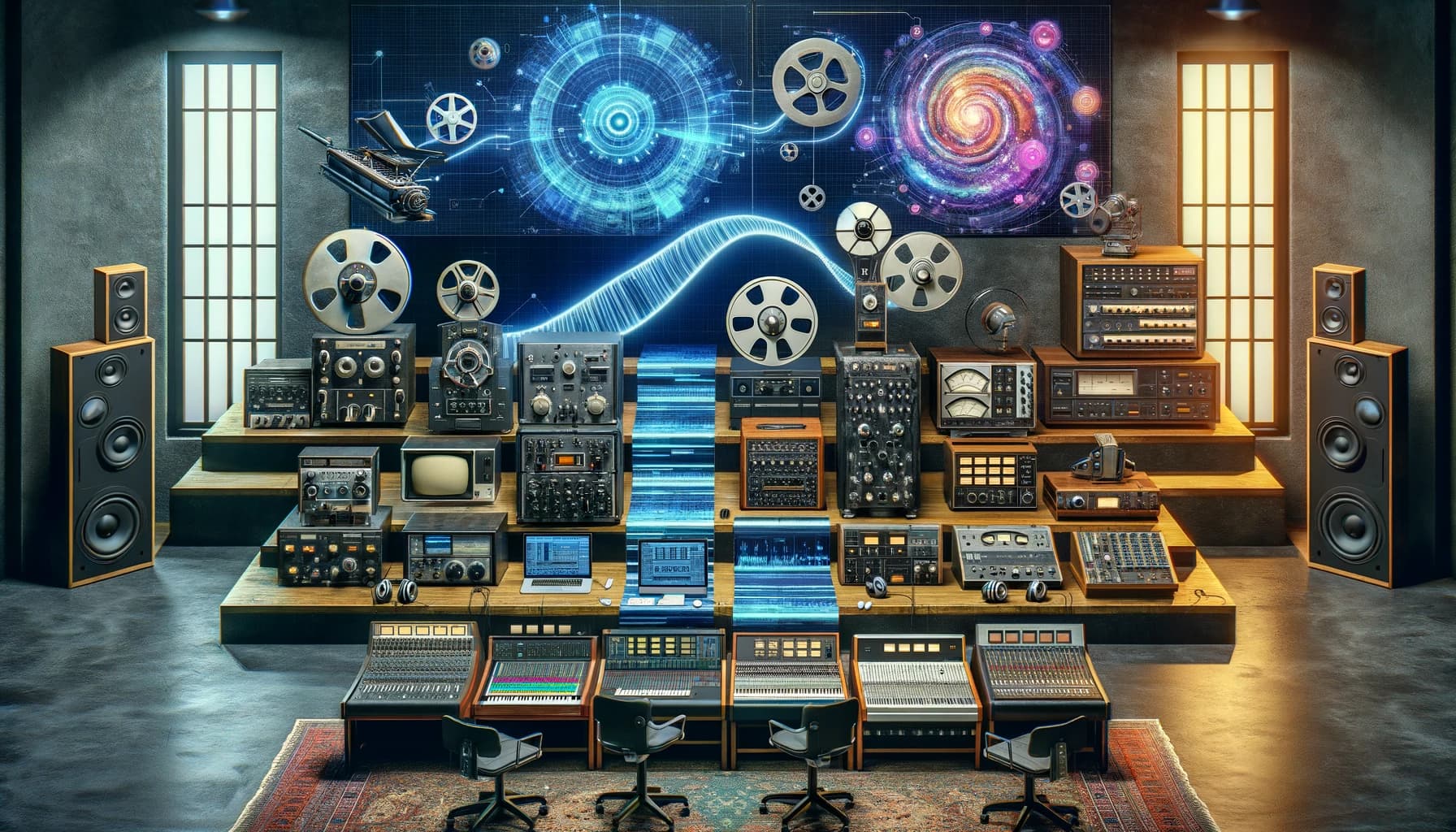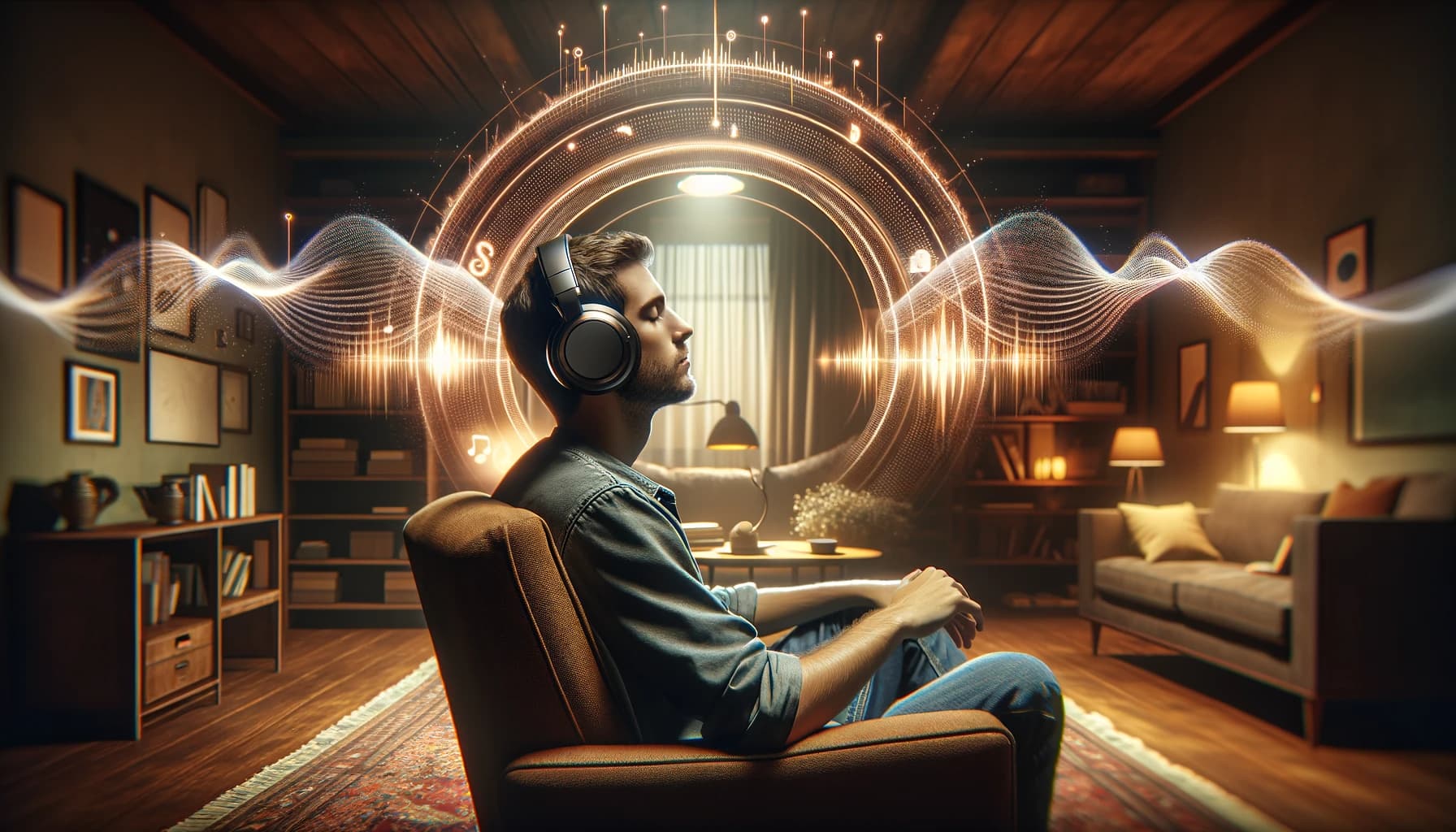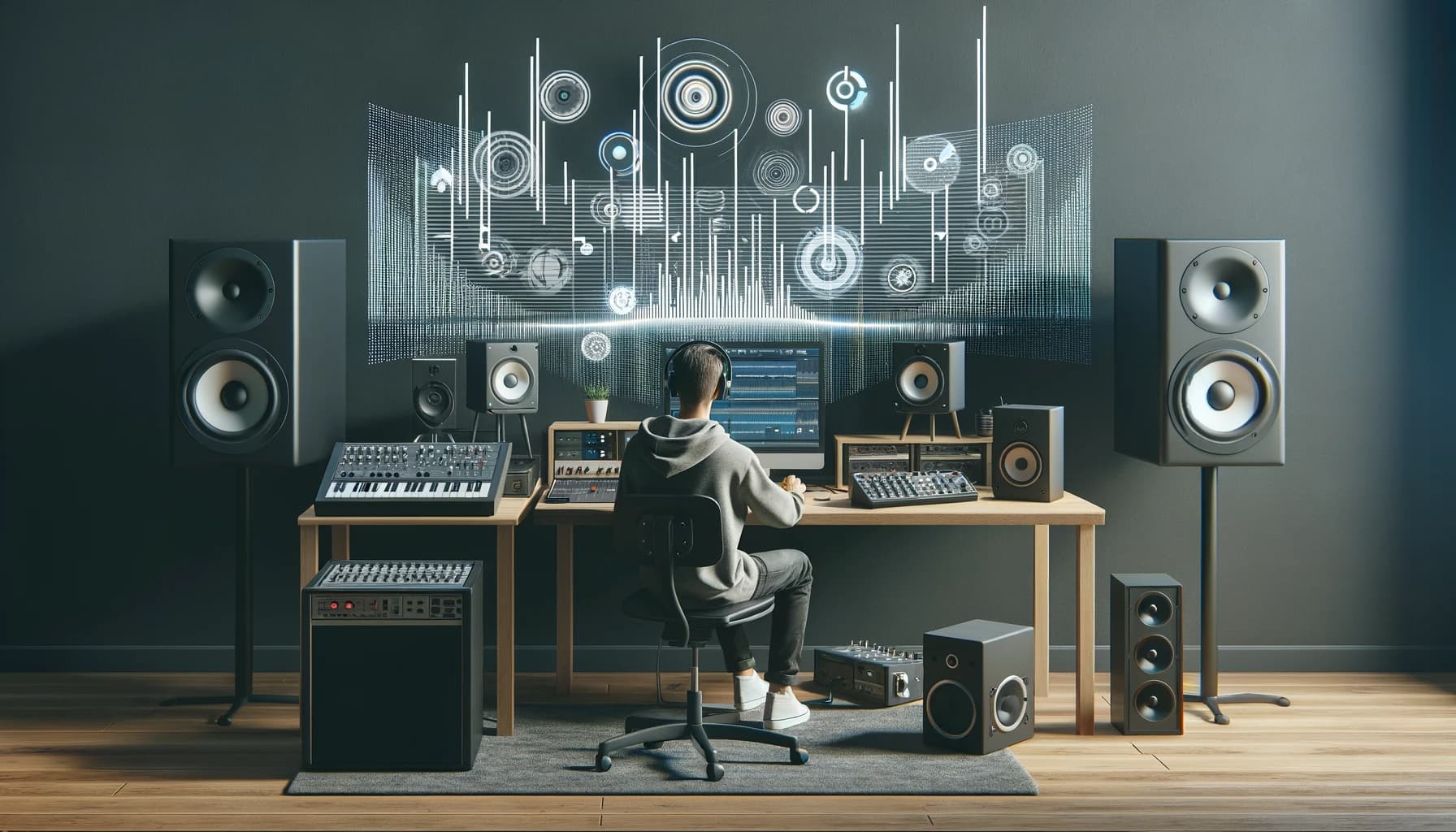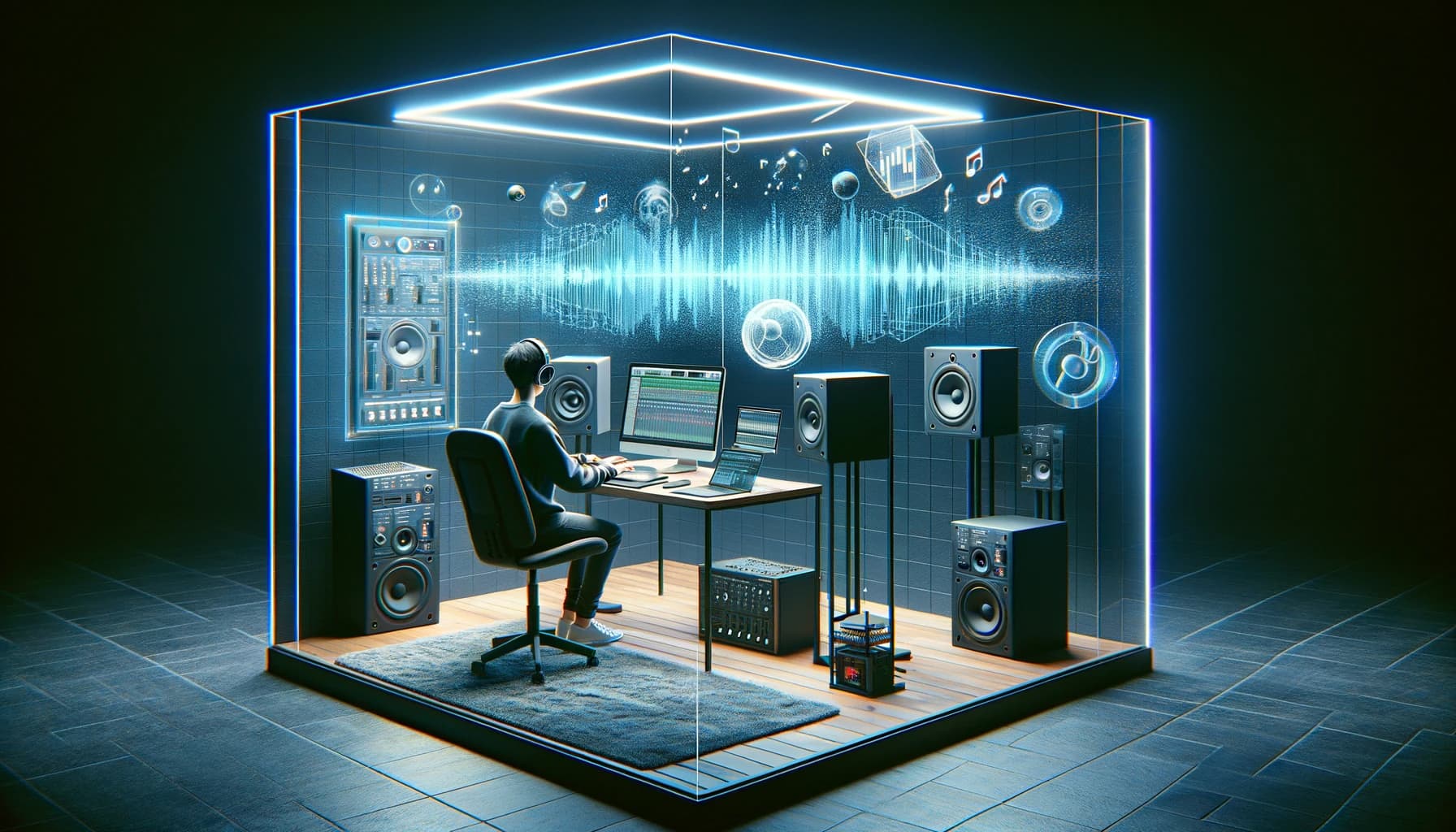Author: Tom Frampton
Source
View Tom Frampton on Plugin Boutique
The art of mastering, a crucial final step in music production, has been continuously evolving, adapting to the ever-changing landscape of technology and listener preferences. As we stand at the threshold of new audio realms, it’s both fascinating and essential to explore the directions mastering is taking. This journey takes us beyond mere adjustments of EQ and compression, leading us into the world of immersive audio experiences, high-resolution formats, and the groundbreaking realm of AI-driven mastering processes.
Mastering, traditionally, has been about balance and enhancement – ensuring that a track sounds its best across various playback systems. It’s an art that requires a critical ear, technical skills, and deep understanding of sonic aesthetics. From the days of vinyl and tape to the digital era, mastering engineers have shaped the soundscape of music, often subtly yet significantly.

Today, we are witnessing a seismic shift in how mastering is approached, driven by advancements in technology and changing listening habits. The introduction of immersive and spatial audio is redefining the boundaries of sound, providing a three-dimensional listening experience that transcends traditional stereo. High-resolution audio formats are pushing the limits of sonic clarity and detail, offering listeners an experience that’s closer to the original studio performance.
Artificial Intelligence (AI) is another frontier that’s reshaping mastering. AI algorithms, equipped with learning capabilities, are now capable of analyzing and processing tracks in ways that were once the sole domain of human engineers. The implications are vast and varied, from democratizing mastering to raising philosophical debates about the role of human touch in this craft.
As we delve deeper into these topics, we will uncover not just how these technologies work, but also their impact on the industry, the artists, and the listeners. We’ll explore the challenges and opportunities they present, and how mastering engineers and music producers can stay abreast in this rapidly evolving field.
In the next sections, we will navigate through the intricate world of immersive audio, understand the nuances of high-resolution formats, demystify AI in mastering, and discuss strategies for staying updated in this fast-paced industry.
And, importantly, we will also make space to discuss ‘the future of Mastering The Mix products,’ linking these innovations to practical tools and solutions that align with these emerging trends.
Join us on this exciting exploration into the future of mastering, where technology meets art, creating new sonic landscapes for us to explore and enjoy.

The Rise of Immersive and Spatial Audio
In the realm of audio mastering, one of the most significant and exciting developments in recent years has been the advent of immersive and spatial audio. This technology, which creates a three-dimensional sound environment, has revolutionized the way we experience music, offering an expansive, engulfing soundscape that extends far beyond the traditional stereo field.
Defining Immersive and Spatial Audio:
Immersive audio, often referred to as 3D audio, is designed to place the listener in the center of the music, enveloping them in sound from all directions. This is achieved through advanced speaker setups, such as Dolby Atmos, Auro-3D, and DTS:X, or through headphones using binaural processing. Spatial audio, on the other hand, focuses on the accurate placement of sound sources in three-dimensional space, giving the illusion that sounds are coming from specific locations around the listener.

A Brief History:
The journey towards immersive audio can be traced back to the era of quadraphonic sound in the 1970s. However, it was not until the proliferation of digital audio technology that the true potential of immersive sound was realized. The introduction of 5.1 surround sound in the late 1990s marked a significant step forward, laying the groundwork for today’s advanced immersive audio formats.
Current Applications and Future Potential:
Today, immersive audio is not only enhancing the listener’s experience in music but also in film, gaming, and virtual reality. Artists are now able to craft soundscapes that offer unprecedented depth, height, and dimensionality. The future potential of immersive audio in mastering is vast, with possibilities extending into interactive music experiences, live performances, and more.
Impact on Mastering:
The mastering process for immersive audio differs significantly from traditional stereo mastering. It requires a different approach to spatialization, equalization, and dynamics, with a focus on preserving the three-dimensional aspect of the mix. Mastering engineers need to have a deep understanding of the format-specific requirements and the technical know-how to deliver a spatially coherent and emotionally impactful master.
Statistics and Industry Adoption:
- The adoption of immersive audio formats has been steadily increasing, with major streaming platforms now supporting formats like Dolby Atmos.
- A 2021 survey revealed that over 60% of audio professionals believe immersive audio will be a standard format within the next five years.
As we delve deeper into the possibilities of immersive and spatial audio, it’s clear that this technology is not just a fleeting trend but a transformative force in the world of mastering. It challenges us to rethink the boundaries of sound and offers an exciting canvas for creative expression and sonic exploration.

High-Resolution Audio Formats: Clarity Like Never Before
The audio mastering landscape is witnessing a significant shift with the advent of high-resolution audio formats. These formats are redefining the standards of sound quality in the digital age, offering an auditory experience that’s closer to the original performance than ever before.
Understanding High-Resolution Audio Formats:
High-resolution audio refers to sound recordings that surpass the quality of standard CD audio. While CDs are typically encoded at 16-bit/44.1kHz, high-resolution formats can offer 24-bit depth and sample rates like 96kHz or even 192kHz. This increase in bit depth and sample rate translates to a broader dynamic range and finer sonic detail, capturing the nuances and subtleties of the music more accurately.
Comparing Formats:
When compared to standard formats, high-resolution audio delivers a clearer, more detailed sound. Listeners can expect a richer bass, more defined midrange, and crisper highs. However, this enhanced quality comes with challenges, such as larger file sizes and the need for compatible playback equipment to fully appreciate the difference.
Impact on Mastering:
For mastering engineers, high-resolution formats require a meticulous approach. The increased detail means that imperfections and errors are more noticeable, necessitating a higher level of precision in the mastering process. Mastering for high-resolution also involves considering the format’s capabilities, ensuring that the final product fully utilizes the extended dynamic range and frequency response.
Market Trends:
- The demand for high-resolution audio is growing, with an increasing number of online platforms offering high-res downloads and streaming.
- A recent survey showed that over 30% of music listeners are interested in upgrading their systems to enjoy high-resolution audio, indicating a growing market.
High-resolution audio is not just a technical upgrade; it’s a move towards a more authentic and immersive listening experience. As this technology becomes more accessible, it’s poised to change not just how we listen to music but also how it’s mastered, bringing us closer to the purest form of the artist’s vision.

AI Mastering: The Algorithmic Revolution
The landscape of audio mastering is undergoing a dramatic transformation with the integration of Artificial Intelligence (AI). AI in mastering is not just a technological novelty; it represents a paradigm shift in how music is processed, refined, and finalized for the listener.
AI in Mastering – An Overview:
AI mastering involves the use of sophisticated algorithms that analyze and process audio tracks. These algorithms are trained on vast datasets of professionally mastered tracks, enabling them to make informed decisions about EQ, compression, loudness, and more. The result is an automated mastering process that can provide consistent and high-quality results in a fraction of the time it takes for traditional mastering.
Case Studies and Practical Applications:
Several platforms now offer AI mastering services, allowing producers and independent artists to access mastering (marketed as ‘professional-quality’ but the debate is still open on that one) without the need for expensive studio time or specialized equipment. This democratization of mastering has opened up new possibilities for artists to produce polished, release-ready tracks on a budget.
Human vs. AI Mastering:
The debate between AI and human mastering is centered around the balance between efficiency and the nuanced touch of a skilled mastering engineer. While AI offers speed and consistency, it may lack the creative intuition and contextual understanding of a human professional. However, as AI technology continues to evolve, it is increasingly complementing the work of human engineers, leading to a hybrid approach that leverages the strengths of both.
Predictions for AI in Mastering:
- AI mastering is expected to become more sophisticated, with algorithms that can adapt to specific genres and artistic styles.
- The integration of AI in mastering tools and software is likely to grow, offering more control and customization to users.
Relevant Statistics:
- A recent survey indicated that over 40% of independent artists have used or are considering using AI mastering services.
- The AI music market is projected to grow significantly, with estimates indicating a multibillion-dollar industry by 2025.
AI mastering is not just about automation; it’s about opening new frontiers in audio processing and allowing creativity to flourish without technical limitations. As we embrace this algorithmic revolution, the future of mastering looks more accessible, efficient, and innovative than ever before.

Staying Ahead in a Rapidly Evolving Field
In the dynamic world of audio mastering, staying informed and adaptable is not just beneficial; it’s essential. As new technologies emerge and industry standards evolve, mastering engineers and music producers must continually update their knowledge and skills to remain relevant and competitive.
Importance of Continuous Learning:
The field of audio mastering is in a constant state of flux, with new techniques, software, and hardware regularly emerging. To deliver the best results and stay ahead of the curve, mastering professionals need to be lifelong learners, continuously updating their understanding of both the artistic and technical aspects of their craft.
Staying Updated with Resources and Strategies:
-
Online Tutorials and Courses: There are numerous online platforms offering courses ranging from basic mastering techniques to advanced concepts in immersive and spatial audio.
-
Industry Publications and News: Subscribing to audio engineering magazines and websites helps keep professionals informed about the latest trends and developments in the industry.
-
Webinars and Workshops: Attending online seminars and workshops conducted by industry experts provides insights into new methodologies and tools.
-
Networking and Community Participation: Engaging with online forums and local communities offers opportunities to share knowledge and learn from peers.

Role of Professional Networks:
Participating in professional networks, attending industry conferences, and engaging in discussions with fellow mastering engineers can provide valuable insights into how others are adapting to changes in the industry.
Anticipating Future Trends:
Mastering engineers should not only keep pace with current trends but also try to anticipate future developments. This involves understanding the direction in which music consumption is heading, such as the rise of immersive audio experiences and the integration of AI in music production.
Staying updated in the rapidly evolving field of mastering is a continuous journey. It requires dedication, curiosity, and a proactive approach to learning and adopting new technologies and methods. By embracing these changes, mastering professionals can ensure that their skills remain relevant and their work continues to resonate with the evolving demands of the music industry.

The Future of Mastering The Mix Products
At Mastering The Mix, we are constantly pushing to be at the forefront of audio innovation, blending state-of-the-art technology with the irreplaceable touch of human creativity. Our journey has led us to develop groundbreaking algorithms that don’t just analyze audio but also provide insightful suggestions to elevate your sound. Our products like MIXROOM and BASSROOM are prime examples, where tonal balance adjustments are intricately tailored based on your selected reference tracks. This harmonious blend of algorithmic precision and human control is a core principle that guides our present endeavors and future aspirations.
Looking ahead to 2024, we are thrilled to introduce FASTER MASTER, our latest venture into the realm of smart, all-in-one mastering solutions. This revolutionary plugin is designed to seamlessly bridge the gap between automated AI mastering and the nuanced approach of traditional mastering workflows. FASTER MASTER is more than just a tool; it’s a smart companion that employs advanced algorithms and machine learning to provide an optimal starting point for your mastering process. But that’s just the beginning. FASTER MASTER also affords you the flexibility and control to fine-tune and sculpt your sound, ensuring that your artistic vision is always at the forefront.
Our commitment to innovation doesn’t stop there. We are excitedly working on a range of new products, each featuring unique, never-before-seen capabilities. These upcoming releases are set to harness the latest advancements in music technology, pushing the boundaries of what’s possible in audio mastering.
As we continue to innovate and grow, we are eager to share these developments with you, our community of music producers and audio enthusiasts. Stay tuned for a future where technology meets creativity, and where your music reaches new heights with Mastering The Mix.

Conclusion – Embracing the Future of Mastering
As we have explored, the future of audio mastering is a tapestry of innovative technologies, evolving formats, and ever-changing industry dynamics. The journey from traditional stereo to immersive and spatial audio, the adoption of high-resolution formats, and the integration of AI in mastering, all represent a significant leap forward in how we create and experience music. These advancements not only redefine the limits of sound quality but also open new creative avenues for artists and mastering engineers.
The role of the mastering engineer is becoming more dynamic than ever, requiring a blend of artistic intuition and technical prowess, complemented by an openness to new ideas and technologies. The key to thriving in this future is adaptability – the ability to learn, evolve, and embrace change. As we’ve seen, staying updated is not just about keeping pace with the latest tools; it’s about understanding the shifting landscape of music consumption and production.

Mastering The Mix is poised at the forefront of these changes, continuously evolving to offer solutions that not only meet the current demands of the industry but also anticipate future trends. This commitment to innovation ensures that music producers and mastering engineers have the tools they need to bring their artistic visions to life, with unprecedented quality and creativity.
As we look to the future, one thing is certain: the world of audio mastering will continue to evolve, bringing new challenges and opportunities. By embracing these changes and exploring new horizons, we can ensure that the music we create and master today will resonate with the listeners of tomorrow.





